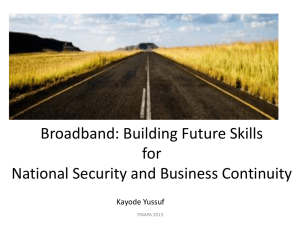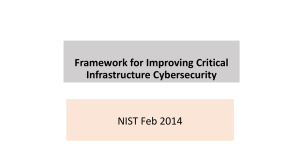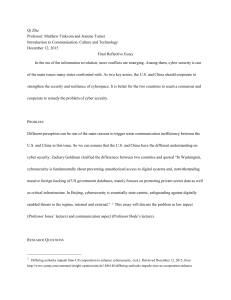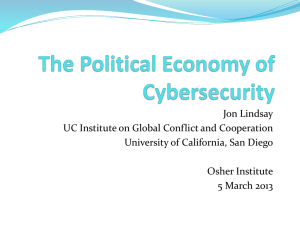White paper #6
advertisement
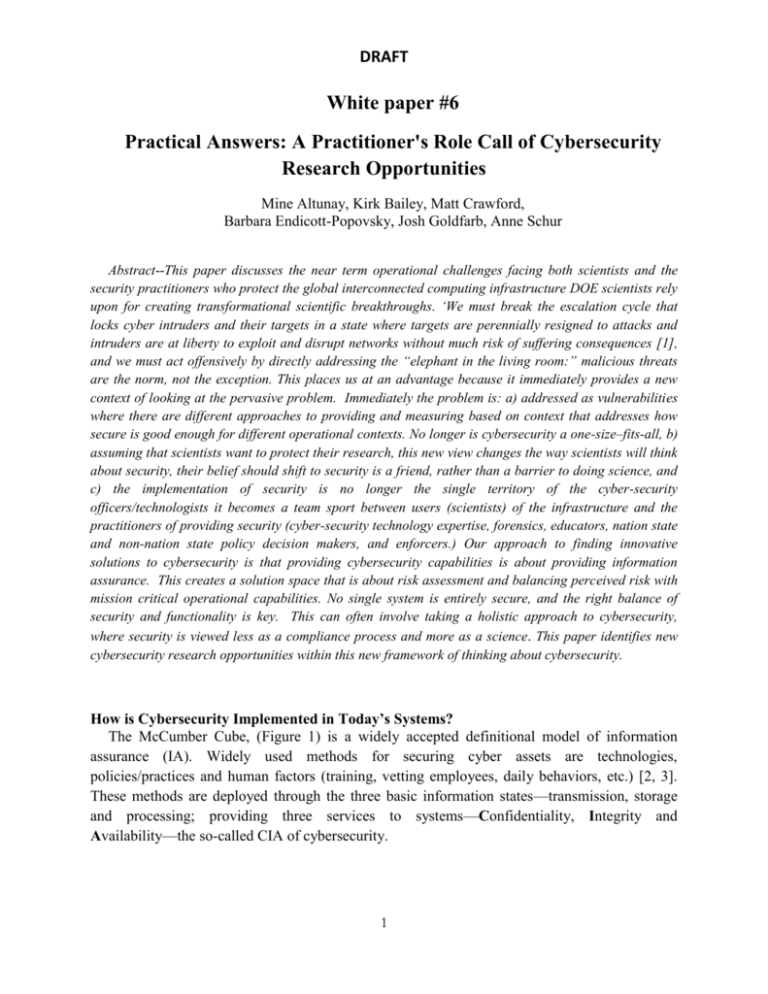
DRAFT White paper #6 Practical Answers: A Practitioner's Role Call of Cybersecurity Research Opportunities Mine Altunay, Kirk Bailey, Matt Crawford, Barbara Endicott-Popovsky, Josh Goldfarb, Anne Schur Abstract--This paper discusses the near term operational challenges facing both scientists and the security practitioners who protect the global interconnected computing infrastructure DOE scientists rely upon for creating transformational scientific breakthroughs. ‘We must break the escalation cycle that locks cyber intruders and their targets in a state where targets are perennially resigned to attacks and intruders are at liberty to exploit and disrupt networks without much risk of suffering consequences [1], and we must act offensively by directly addressing the “elephant in the living room:” malicious threats are the norm, not the exception. This places us at an advantage because it immediately provides a new context of looking at the pervasive problem. Immediately the problem is: a) addressed as vulnerabilities where there are different approaches to providing and measuring based on context that addresses how secure is good enough for different operational contexts. No longer is cybersecurity a one-size–fits-all, b) assuming that scientists want to protect their research, this new view changes the way scientists will think about security, their belief should shift to security is a friend, rather than a barrier to doing science, and c) the implementation of security is no longer the single territory of the cyber-security officers/technologists it becomes a team sport between users (scientists) of the infrastructure and the practitioners of providing security (cyber-security technology expertise, forensics, educators, nation state and non-nation state policy decision makers, and enforcers.) Our approach to finding innovative solutions to cybersecurity is that providing cybersecurity capabilities is about providing information assurance. This creates a solution space that is about risk assessment and balancing perceived risk with mission critical operational capabilities. No single system is entirely secure, and the right balance of security and functionality is key. This can often involve taking a holistic approach to cybersecurity, where security is viewed less as a compliance process and more as a science. This paper identifies new cybersecurity research opportunities within this new framework of thinking about cybersecurity. How is Cybersecurity Implemented in Today’s Systems? The McCumber Cube, (Figure 1) is a widely accepted definitional model of information assurance (IA). Widely used methods for securing cyber assets are technologies, policies/practices and human factors (training, vetting employees, daily behaviors, etc.) [2, 3]. These methods are deployed through the three basic information states—transmission, storage and processing; providing three services to systems—Confidentiality, Integrity and Availability—the so-called CIA of cybersecurity. 1 DRAFT Figure 1. The McCumber Cube defining information assurance [2, 3] While this framework has served us well in the past and has all the right words to address cybersecurity, it falls short because using these fundamentals has us developing “state-of-the art” solutions based on traditional practices focused on mechanisms and controls rooted on principals of 50-year old computing environments and a mindset of putting in place physical barriers and where a security breach was the exception. The familiar controls-based principles of “access of least privilege” and “separation of duties” and the “Bell-Lapadula” security model are of less relevance in today’s high stakes cyber-conflict. Statistics from the FBI reinforce the notion of thinking about cybersecurity in terms of managing breach as a daily occurrence, rather than responding to intrusion after-the-fact. If FBI estimates are correct that 75% of online traffic is malicious, that organized crime makes more money on the Internet than through drugs, and that the criminal ‘take’ last year from the Internet almost doubled e-commerce revenues,1’ then the set of circumstances in which our laboratories operate online today is untenable. If just 1% of the World Wide Web’s population has criminal intent, with over 1.2 billion people online, every log onto the Internet exposes you to potentially 120 million malicious users. It’s no longer a question of ‘if’ you will be attacked, but rather, ‘when.’ To get to new levels of state-of-the-art there is a greater need for innovation and proofs of concept for radically new operational practices (strategies) and tactics. Imagine you are living in a huge home with hundreds of rooms and you want to go to bed and get a good night sleep; 1 FBI 2007 presentation to the Agora, University of Washington. 2 DRAFT however, before you go to bed you want to make sure you, the house, and your possessions are safe. Now if you are living in a world where it is known that your home already has intruders in it and others will be coming and going as a constant state, what can you do to get a good night’s sleep? Given this context, innovative solutions to performing open science throughout DOE must be derived from the operational challenges of providing and sustaining cybersecurity as an interdisciplinary team sport between users (scientists) of the infrastructure and the practitioners of providing security (cyber-security technology experts, digital forensics investigators, educators, nation state and non-nation state policy decision-makers, and enforcers. Information assurance applied to the domain of cybersecurity must be exercised in a context where no single system is entirely secure, and the right balance of security and functionality is key. This must involve taking a holistic approach to cybersecurity, where security is viewed less as a compliance process and more as a science. Risk assessment and the balancing of perceived risk must be done in the context of our new science missions, their critical operational capabilities that occur in a compromised world, and from the perspective of scientists “doing science”. The Scientist’s Perspective Historically, while researchers are accustomed to protecting their research data, they have not been focused on broader cybersecurity considerations. Moreover, very little information is available which addresses the specific needs of the Open Science research community from a human factors perspective that includes understanding how the IA practitioner and scientist coexist to perform the enterprise of science. IA should be engaged in enabling, sustaining and maintaining the mission of science. To improve the security of the Open Science community, we need to investigate and understand how the community does its work that brings together the two principal users: 1) the IA representative, whose charter is to provide and sustain the infrastructures, tools, and data that scientists, as consumers, use to do their research; and 2) the scientist, whose charter is to do research i.e. to be a consumer/user. Security and science activities need to be unobtrusively integrated to create an enterprise that is an enabler of science for a broad range of use contexts that typically fall into three areas: Performing the full experiment life cycle: Scientists can perform their activities at a single site (a closed environment of conduct), remotely (geographically dispersed from their instruments and colleagues), or in some combination. Data analysis activities: Data captured from experiments is processed and analyzed. These analysis activities might have the same needs as performing experimentation such as interoperability and/data information sharing. Traditional data/information sharing [6]: Data/information is shared in real-time and non real-time in many different media forms that enable the scientist to perform their science experiments and analysis. For example, working in real-time with other 3 DRAFT geographically dispersed people, scientists might need the capability to monitor and control an experiment, while for analysis activities they may need electronic whiteboards. When not working in real-time, tools that facilitate data exchange, such as email and portals are required to be available 24/7. To meet the security needs of the open science community, a unique challenge to the cyber technology community is to keep science going 24/7 in an enterprise that has taken on the characteristic of being distributed in nature; it is an e-campus. No longer do researchers run their jobs on a single local system -- now they may use, and be dependent on, networked resources distributed around the country and/or around the world. In this operational environment, even "simple" things, like authentication, can be a challenge. Techniques to protect data, while affording the availability of efficient science capabilities, are critical. Ease of doing science safely in a networked world should be as easy as flipping a light switch. The Operations Practioners’ Perspective This white paper identifies research opportunities from the operating assumption that all networks and systems are, or will be, compromised. This approach sets a new tenant of operating principals upon which to build a research agenda that takes on an offensive, rather than a defensive, posture for very specific scientific activity mission spaces: “All Cyber Conflicts are Fought on Local Networks – in the Cyber-Battle Space Your Network is the High Ground” “Local Cyber-Conflict Mandates a Priority for Localized Intelligence Gathering and Information Sharing” “Nothing is More Important than Reducing Attack Surfaces and Attack Vectors (you want box canyons)” “Preparing the Local Cyber-Battle Space for conflict is more important than Stopping Intrusions” “Keep the Playing Field Level – Eliminate Rules of Engagement for the Local Network” “Integrate Deception into Local Operations as Much as Possible – Keep the Fight as Unfair as Possible” “Weaponized Local Systems and Data is an Option that Should not be Overlooked” 4 DRAFT “On the Local Network, Offensive Measures have a Huge Advantage over Defensive Measures” To meet these tenants and provide state-of-the-art capabilities, it is imperative that we do not immediately jump into tool-building and new architectures. Instead, we propose that radically new operational strategies and tactics be formulated that address the new environments in which open science is performed, associated with the following areas: o Organization and Authority – Focuses on the roles and responsibilities for providing the required leadership/ownership, objectives and resources for the development and enforcement of all cyber-security programs. Policy – Focuses on establishing appropriate policy oversight of IT security policies and supporting IT security efforts that set required standards, guidance and enforcement to meet compliance and risk requirements. o Audit and Compliance – Focuses on compliance and audits within the organization to provide management and regulators with assurance that controls are adequately designed and operating effectively to meet compliance and risk management requirements. o o Risk Management and Intelligence – Focuses on proactively identifying new threats, vulnerabilities, and risks outside and inside the organization through key strategic alliances, innovative information gathering, and information sharing practices. Also focuses on on-going risk assessments, identification of risk tolerance levels, and implementation of associated risk control programs. Privacy – Focuses on information privacy and protection within the organizational business framework and institutional policy and compliance requirements. o Incident Management – Focuses on response and resolution of information security incidents to minimize the business impact and risk of further incidents, as well as meet all legal and/or contractual requirements. o o Education and Awareness – Focuses on the planning, procedures, documentation and implementation of security awareness, education and related training for employees, service providers, students, faculty, and other users of the computing research and computing resources within DOE and other entities. 5 DRAFT Operational Management – Focuses on appropriate security controls and operational practices for networks, computer systems, applications, and data throughout entities involved in the open science enterprise. o o Technical Security and Access Control – Focuses on the controls that restrict access in compliance with Information Systems Security Policy and its stated operating principles (“Access of Least Privilege” and “Separation of Duties”). o Monitoring, Measurement and Reporting – Focuses on the controls that define the event information that will be logged and monitored, adequate analysis of the information and the alert levels that will be triggered for incident response. o Physical and Environmental Security – Focuses on physical protections of data center/physical assets and data from theft, damage or loss. o Asset Identification and Classification – Focuses on planning and operational procedures related to inventory, accountability and responsibility, classification and implementation of associated controls. o Account Management and Outsourcing – Focuses on the policy and procedures governing the hiring, transfer, termination, and clearance processes for employees, contractors, and venders. As a starting point to address the above elements, it might be useful to adapt the model depicted in Table-1. This model has the potential to define new operations from a team point of reference. The security strategy addresses holding intruders accountable, and gives a framework to think of tools from multi-disciplines such as digital forensics, legal remedies and active defense. TABLE I 4R MODEL FOR ACCOUNTABLE SYSTEMS Security Strategy Tools Resistance Ability to repel attacks 6 Firewalls User authentication Diversification DRAFT Recognition 1) Ability to detect an attack or a probe 2) Ability to react / adapt during an attack Intrusion detection systems Internal integrity checks Recovery 1) Provide essential services during attack 2) Restore services following an attack Incident response ("forensics" - the what)2 Replication Backup systems Fault tolerant designs Forensics - the who Legal remedies Active defense Redress 1) Ability to hold intruders accountable in a court of law. 2) Ability to retaliate Role Call of Cybersecurity Research Opportunities First and foremost, the DOE cybersecurity environment exists to enable operations that support the scientific community. Before any additional security mechanisms/procedures are implemented, the focus must remain on providing robust services, meeting customer service expectations, and ensuring customers that the computing infrastructure is reliable. Today this means that the operational community3 requires certain conditions be met by any cybersecurity innovation: 1) Any technical security protections, provided outside its own control, must be predictable in operation. In other words, service operators must be able to predict the response of technical security controls to any legitimate use or operation of a service. Further, to the greatest extent possible, the configuration and operation of such controls should be open to inspection by operators of affected services. 2) Host-based security controls must be compatible with the need to make regular patches to operating systems and software. Patches and updates to other security controls must be made on schedules consistent with operation of those services supported by affected hosts. (Exceptions may be made for severe vulnerabilities under current attack.) 2 While forensics (small "f"), is part of Recovery in the 3R model [1], it is not rigorous enough for capturing evidence admissible in a courtroom, with its focus is on discovering what happened in order to restore network function quickly [1]. Redress requires computer Forensics (capital "F"), which focuses on establishing who is responsible in order to develop suitable evidence to hold them accountable in a court of law. 3 Note that for the purposes of this white paper, "operational community" means those groups within a DOE or Contractor site which operate network-accessible services. 7 DRAFT 3) Network-based testing and verification of host security must not become a denial-ofservice attack by itself. New tests against hosts providing services, and new intensity levels of existing tests, must only be initiated in cooperation with service operators. Research Grand Challenge Opportunities 1) Scientists do their science in an interconnected system that is growing dynamically. The number of accounts and passwords associated with these systems is also increasing and scalability supporting authentication is becoming harder. There is a need for new authentication paradigms that will usably scale to increasingly complex networked environments. 2) Because of the complexity of the networked environment, scientists are no longer able to self-monitor their infrastructure and respond to adverse events. Techniques (such as new visualizations) are needed to assist them to be situationally aware of the status of their infrastructure, make decisions and determine actionable coordinated responses that mitigate the adverse event. 3) New ways of doing open science may require new method and metrics to systematically track successes and promotes cyber-safe culture behaviors, versus behaviors that are geared to meet auditing requirements. As examples: a) Measures that can serve as indicators about how well IA and scientists are integrating their roles in open science to provide a safe-cyber culture rather than separate measures for each. These measures should include usability in areas of deployability, supportability, accessibility, complexity versus security, and b) Measures that enable the assessment of how sufficient is the security for a particular mission. As part of the development of this effort, the research agenda might address a modeling and simulation test-bed that can assess the impacts of policies for all stakeholders --- a science research sim city if you will. 4) Policies that are based on how secure you (the scientist with his/her collaborators) are in your particular environment. Security is based on context rather than a one-size-fits-all. 5) Often missed is the idea of containment and distributed incident management. This should include how others (humans and IT systems) should be alerted to prevent spread of the impact of the event. 6) Weaponizing the data for a variety of tactical purposes. The idea is to make data dangerous, instead of encrypting it, because encryption is so easily mis-used in expensive and un-welcomed ways. It’s also administratively heavy and expensive. Dangerous data can be far more valuable, and likely more effective, for more nimble, flexible and cheap defensive strategies. This is offensive capability that not only protects, it provides immediate negative consequences to the perpetrators removing the “human factor” reward built into our current systems and culture that favors the perpetrators. Thus perpetrators become accountable due to the means of deterrence, rather then the victims being the one’s held accountable. (NOTE from Kirk: 8 DRAFT Can one of you scientists please invent this capability tonight for me? You would be pleased to see how well I would use it.) 7) Deriving operational practices of engagement that promote the culture of doing science as a team sport. This, in turn, will create new needs for developing metrics, education, and training, 9 DRAFT Bibliography [1] Endicott-Popovsky, B.E., Frincke, D. "Adding the Fourth 'R': A systems approach to solving the hacker's arms race." Hawaii International Conference on System Sciences (HICSS) 39 Symposium: Skilled Human-intelligent Agent Performance: Measurement, Application and Symbiosis, 4 January 2006, Kauai, HI, Retrieved Feb. 17, 2007 from the World Wide Web: http://www.itl.nist.gov/iaui/vvrg/hicss39/4_r_s_rev_3_HICSS_2006.doc. [2] Maconachy, V., Schou, C., Ragsdale, D. and D. Welch, “A model for information assurance: an integrated approach,” in Proceedings of the 2nd Annual IEEE Information Assurance Workshop, June 2001, USMA, West Point. [3] McCumber, J. (1991). "Information systems security: A comprehensive model," in Proceedings of the 14th National Computer Security Conference, Washington, D.C., October, 1991; reprinted in the Proceedings of the 4th Annual Canadian Computer Security Conference, Ottawa, Ontario, May, 1992; reprinted in DataPro Reports on Information Security, Delran, NJ: McGraw-Hill, 1992. [4] Ellison, R.J., Fisher, D.A., Linger, R.C., Lipson, H.F., Longstaff, T.A. and. N.R. Mead. (May, 1999). "Survivable network systems: An emerging discipline. CMU/SEI 97-TR-013," Software Engineering Institute, Carnegie-Mellon University, Pittsburgh, PA. [5] Ryan, D. "New directions in cyber law. Paper," Presented at the CISSE 7th Colloquium. June 2003, Washington, D.C. [6] Schur, A., Meyers, JD, Keating, KA, Payne, DA, Valdez, T, and Yates, K. “Collaborative Suites for Experiment Oriented Scientific Research.” ACM’s Interactions Vol.5. No.3. May/June 1998 pp.40-47. See Kirk’s Appendix Kirk’s Appendix A attached. 10

